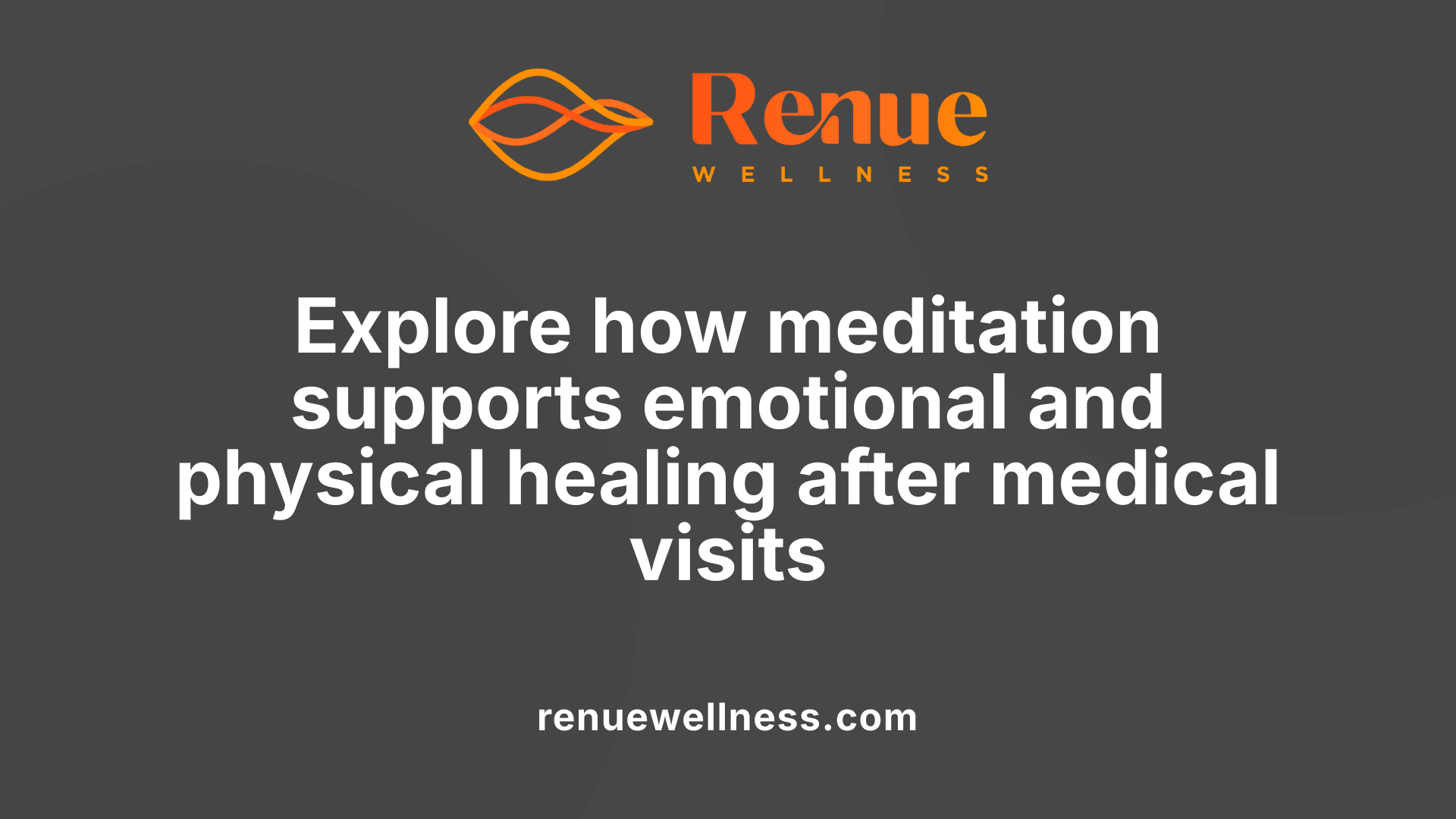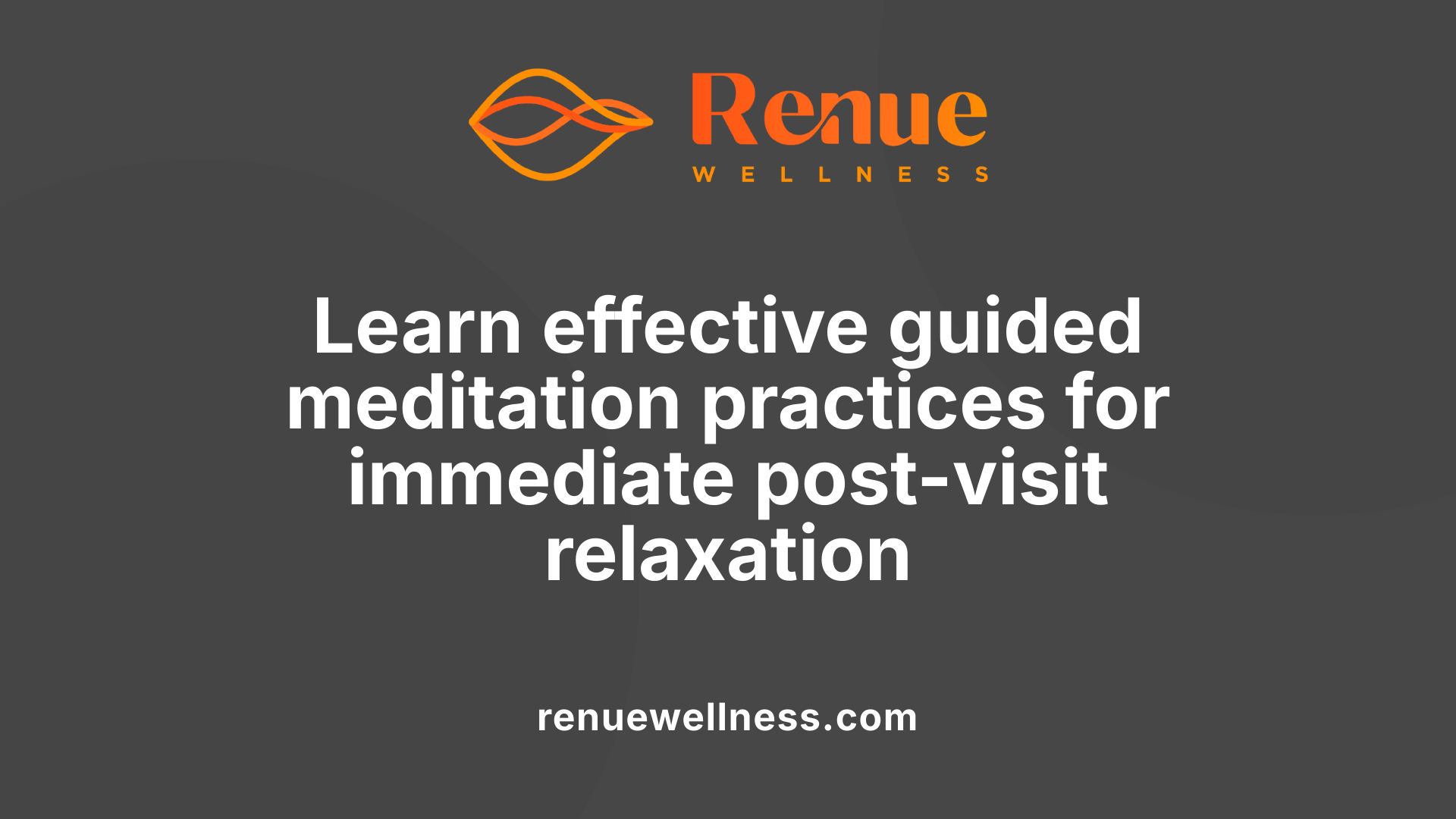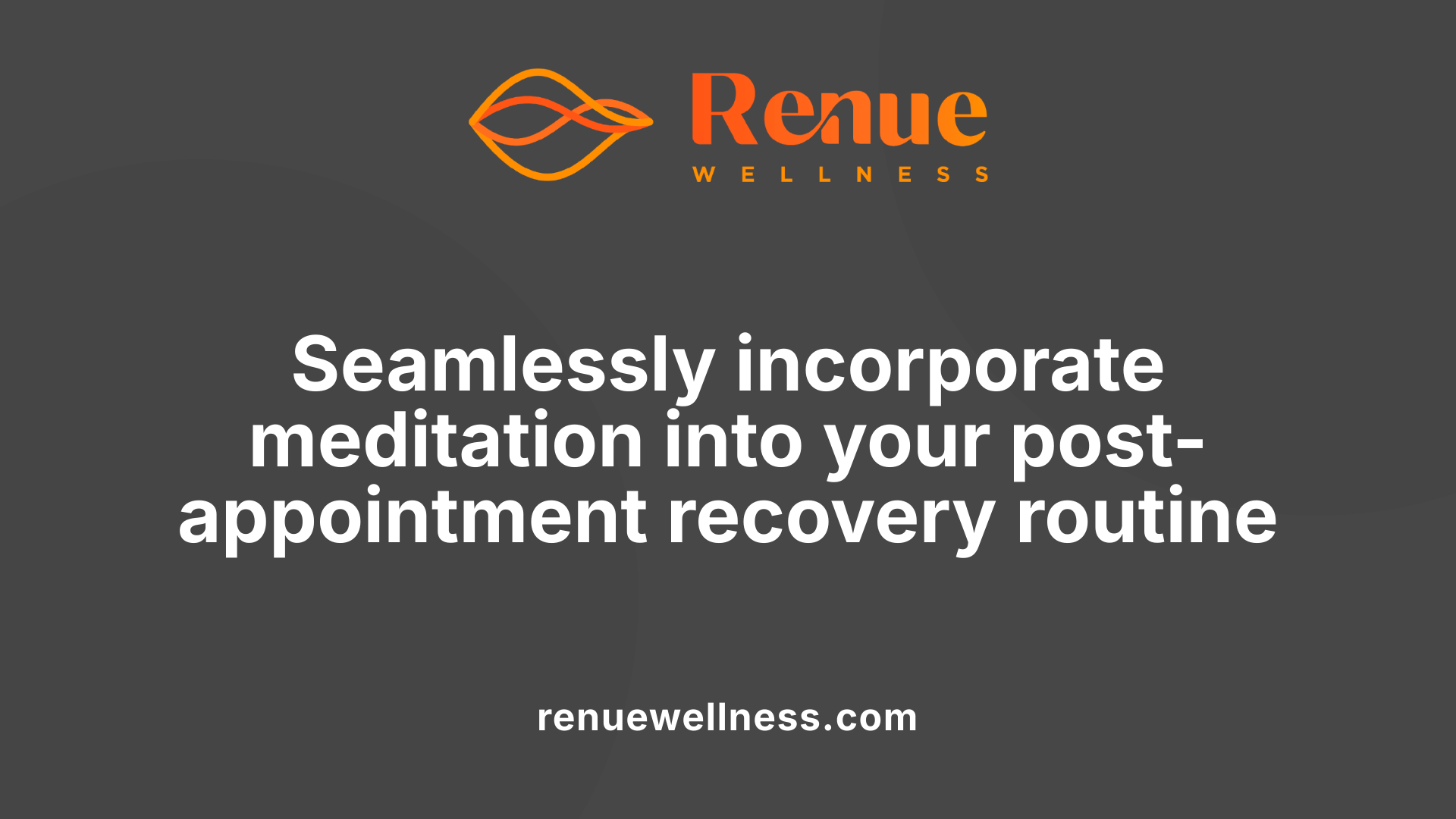Meditation Tracks to Use After Your Appointment


July 17, 2025
Embracing Post-Appointment Relaxation with Meditation Tracks
Medical and therapeutic appointments can often leave individuals feeling anxious, stressed, or physically tense. Incorporating meditation tracks designed specifically for relaxation after such visits can significantly promote recovery, emotional stability, and a sense of well-being. This article explores the benefits of these meditation resources, the types of sounds and music that aid recovery, and practical ways to incorporate them into your routine for maximum benefit.
Understanding the Role of Meditation in Post-Appointment Recovery

What are the benefits of using meditation and relaxation tracks after appointments?
Using meditation and relaxation tracks after medical appointments can significantly support both mental and physical recovery. These guided practices help reduce immediate feelings of stress and anxiety, creating a sense of calm that can be therapeutic in the healing process.
Many tracks incorporate deep breathing, grounding visualization exercises, and calming sounds like binaural beats with theta waves to promote relaxation. For instance, UCLA Health offers professionally recorded meditations by experts like Diana Winston that are designed to help users relax and regain emotional equilibrium.
Regular engagement with these resources can lead to tangible health benefits. These include lower blood pressure, improved sleep quality, and reduced pain perception. Moreover, meditation fosters emotional regulation, helping individuals recognize and accept feelings like anxiety as normal, which can prevent these emotions from escalating.
Finally, meditation enhances mental clarity and compassion, supporting resilience in ongoing recovery. Incorporating meditation into post-appointment routines is an accessible and effective way to promote overall well-being and help individuals manage stress more effectively.
What are some guided meditation resources suitable for post-appointment relaxation and stress relief?
Several reputable resources are available for those seeking guided meditation to aid recovery after medical visits. UCLA Health’s guided meditations, produced by experts including Dr. Charlotte Howard and Diana Winston, are among the most widely recommended. These tracks are accessible via download or streaming, available in multiple languages such as English, Spanish, and Arabic. They are part of UCLA Mindful's offerings and are licensed under Creative Commons, making them freely available for personal use.
These meditations include topics like grounding, breathing exercises, body scan, and imagery to help create a safe and calming environment. Examples are 'Relaxing Breathing,' 'Gentle Body Scan,' and 'Guided Imagery,' with scripts sourced from trusted providers like Whole Person Associates. Using these resources regularly can help individuals develop skills in calming their mind and body, which can be especially helpful after stressful procedures.
Other credible sources include organizations like InsightLA, Kaiser Permanente, and the InsightTimer app, which provide free practices tailored for stress reduction and relaxation. These offer diverse formats, including podcasts, downloadable audio files, and live sessions.
Listening to calming music or sounds—such as rain, nature sounds, or gentle instrumental music—can enhance the effectiveness of guided meditations. Music around 60 beats per minute can synchronize brainwaves toward a relaxed alpha state, further facilitating calmness.
In summary, these guided resources, created by trained professionals with credentials such as PhD, MD, and RN, support individuals through their recovery journey, connecting mental, emotional, and physical benefits. Whether through dedicated apps, websites, or downloadable tracks, accessible and consistent meditation practice can become a valuable part of post-appointment care, enhancing overall health and resilience.
Guided Meditation Techniques for Post-Appointment Relaxation

Are there specific meditation techniques recommended for post-appointment relaxation?
Yes, there are several meditation practices that are particularly effective for calming the mind and body after a medical appointment or procedure. These techniques help manage residual anxiety, physical discomfort, and emotional stress, promoting a quicker return to a relaxed state.
Deep Breathing Exercises
Deep breathing is a foundational technique often recommended for immediate relaxation. It involves taking slow, deliberate breaths that fill the lungs fully and then gently releasing the air. This process signals the nervous system to shift from a stress response to a calming state. Techniques like diaphragmatic or belly breathing are especially beneficial, as they encourage full oxygen exchange and reduce tension.
Body Scan Meditation Practices
Body scan meditation encourages individuals to focus attention sequentially on different parts of their body. This practice increases body awareness and helps release physical tension accumulated during stressful procedures. Starting from the feet and moving upward or vice versa, practitioners notice sensations, discomfort, or tension, and consciously relax those areas. It serves as a grounding exercise, reconnecting one with present sensations and promoting deep relaxation.
Mindfulness and Guided Imagery
Mindfulness involves paying close attention to present-moment experiences without judgment. Guided imagery takes this a step further by imagining calming scenes, such as a peaceful forest or gentle waves. These visualizations can be guided through audio recordings created by professionals, helping to shift focus away from discomfort or anxiety. Incorporating mindfulness and imagery fosters mental calmness and physical relaxation, making it easier to recover emotionally from medical experiences.
Loving-kindness and Body Awareness Exercises
Loving-kindness meditation focuses on generating feelings of compassion and goodwill toward oneself and others. This approach can help counter feelings of frustration or fear linked to health concerns. Combined with body awareness exercises, it encourages gentle acknowledgment of emotional and physical states, fostering acceptance and resilience.
Implementation in Practice
Engaging in these meditation techniques regularly, even for just 5 to 10 minutes, can lead to noticeable improvements in relaxation and emotional well-being. Many guided recordings available through platforms like UCLA Mindful offer structured practices in these areas, often incorporating binaural beats, calming music, and scripts by qualified professionals.
In summary, adopting these meditation tools after a medical appointment can enhance recovery, reduce stress, and reinforce a sense of calmness. They are accessible, easy to learn, and can be practiced anywhere—making them valuable companions during health journeys.
Integrating Meditation Into Your Healing Routine

How can I incorporate meditation practices into my routine after medical or therapeutic appointments?
Incorporating meditation into your routine after medical or therapeutic appointments can be a simple yet effective way to support your emotional and physical healing. One practical approach is to set aside a few minutes immediately following your appointment, allowing yourself to transition from the clinical environment to a space of calm.
You might find it helpful to practice mindfulness through deep breathing exercises, grounding visualization, or guided meditations available on various resources like UCLA Health or meditation apps such as Insight Timer. For example, taking calming breaths or visualizing leaving stress behind as if passing through a doorway can create a mental boundary that signals your nervous system to relax.
Many guided meditations include binaural beats—such as calming theta waves—or scripts that focus on body sensations like the feet to promote grounding and ease anxiety. Incorporating these practices in spots like your car, at home, or even at your desk makes it manageable despite busy schedules.
Consistency is essential. Practicing for just five to ten minutes daily can reduce stress and enhance your well-being. Over time, this helps prepare your mind and body for future appointments, making each subsequent experience less stressful.
To support this process, use meditation apps that provide accessible, multilingual content, such as UCLA Mindful’s offerings created by experts like Diana Winston. The structured guidance can help you stay focused, especially as a beginner.
Beyond solitary practice, journaling about your experiences or engaging with meditation communities online or locally can bolster your commitment. Sharing your progress and insights reinforces your routine and connects you with others on similar journeys.
In summary, integrating meditation after appointments involves quick, accessible exercises tailored to your needs, supported by digital resources and community for sustained benefits. This simple addition to your healing journey can foster greater resilience, relaxation, and overall health.
Choosing the Right Music and Sounds for Post-Visit Calmness
 After medical appointments or procedures, engaging in calming sounds and music can significantly enhance relaxation and aid recovery. Different types of soothing auditory stimuli—such as nature sounds, binaural beats, and gentle music—are effective in promoting mental and physical calmness.
After medical appointments or procedures, engaging in calming sounds and music can significantly enhance relaxation and aid recovery. Different types of soothing auditory stimuli—such as nature sounds, binaural beats, and gentle music—are effective in promoting mental and physical calmness.
Among these, nature sounds like rain, thunder, or ocean waves evoke a sense of peace by mimicking natural environments. These sounds help drown out stressful noise and encourage a meditative state. Binaural beats, especially theta waves, are designed to synchronize brain activity, creating a state of deep relaxation or even aiding sleep. Listening to soothing music, including classical, jazz, or soft instrumental tracks, can quickly reduce stress levels.
Music plays a neurobiological role in stress relief through brainwave synchronization. When the brain perceives music around 60 beats per minute, it tends to align its own rhythm with the beat, fostering alpha brainwaves associated with calm awareness. Longer listening sessions—around 45 minutes—can even induce delta brainwaves, which are linked to restorative sleep.
For comfort, it’s advisable to select familiar or preferred music. Listening to music that you personally find relaxing or uplifting enhances emotional safety and makes it easier to unwind. Creating personalized playlists with favorite tracks or soothing sounds has been shown to improve overall recovery experiences.
Incorporating sound therapy with traditional relaxation practices can further support well-being. For example, guided imagery sessions often include subtle background sounds that evoke peaceful imagery. Similarly, mindfulness exercises paired with calming sounds can deepen mental focus and bodily relaxation.
| Sound Type | Benefits | Ideal Usage |
|---|---|---|
| Nature Sounds | Reduce stress, evoke tranquility | During meditation, relaxing baths |
| Binaural Beats | Synchronize brainwaves, promote sleep | Before sleep, post-appointment relaxation |
| Soothing Music | Lower heart rate, decrease cortisol levels | During recovery, calming routines |
| Personalized Playlists | Enhance emotional comfort, motivation | Continuous listening during rest |
Choosing the right sounds depends on personal preference but prioritizes those that evoke feelings of safety and calm. Whether it’s the gentle plucking of Indian sitars, Celtic flute melodies, or the sounds of rain and birds, the goal is to create a healing environment that fosters mental serenity and physical relaxation.
The Science and Benefits Behind Post-Visit Meditation and Music
How does brainwave synchronization with music at 60 beats per minute support relaxation?
Listening to music with a tempo of around 60 beats per minute can influence brain activity significantly. This rhythm often causes the brain to synchronize with the beat, producing alpha waves that are associated with states of calm, alertness, and relaxed wakefulness. Research indicates that such slow-tempo music can promote mental relaxation and reduce stress levels. Additionally, when listened to for at least 45 minutes, this type of music can also induce delta waves, which are linked with deep sleep and restorative rest. This makes calming music an effective tool for soothing the mind after stressful medical appointments.
What evidence supports meditation in reducing stress and improving quality of life?
A substantial body of scientific research demonstrates that meditation can help lower stress levels, decrease symptoms of depression and anxiety, and improve overall well-being. For example, studies from renowned institutions like Stanford University show that listening to calming music can alter brain functioning similarly to medication, providing accessible relief from stress.
Meditation practices such as guided imagery and mindfulness have shown positive effects on pain, fatigue, sleep, and emotional health, especially in individuals facing health challenges like cancer. These practices support the body's recovery process by fostering relaxation, enhancing mental clarity, and regulating emotions.
How does professional and licensed content enhance the effectiveness of meditation aids?
Content created and recorded by qualified professionals—such as PhDs, MDs, RNs, and music therapists—ensures that meditation and relaxation tracks are safe, effective, and scientifically supported. For instance, UCLA's guided meditations developed by Diana Winston, UCLA Mindful’s director, and other expert recordings incorporate the latest insights into mindfulness, breathing, and visualization techniques.
Licensed scripts from organizations like Whole Person Associates further guarantee that the content is rooted in reputable relaxation and imagery methods. The professional input ensures that each track uses appropriate language, structure, and pacing to maximize relaxation and therapeutic benefits.
What role do cultural and natural sounds play in promoting relaxation?
Natural sounds such as rain, thunder, and nature ambiances are profoundly calming and are often integrated into meditation tracks. These sounds can enhance feelings of peace and create a soothing environment conducive to relaxation.
The use of traditional music instruments from different cultures—like Native American drums, Celtic strings, Indian flutes, and other ethnic instruments—can also evoke deep relaxation. Listening to music that resonates personally fosters emotional connection, which enhances the calming effect.
Moreover, music that you personally find relaxing and enjoyable is most effective for reducing tension. For example, some may prefer classical, jazz, or easy listening tunes, while others might find peace in nature sounds. Combining culturally relevant sounds with meditative practices helps individuals reach a relaxed state more quickly and deeply.
Overview of Meditative and Musical Support for Healing and Recovery
| Aspect | Description | Benefits | Additional Notes |
|---|---|---|---|
| Brainwave Entrainment | Music at 60 bpm synchronizes brainwaves | Promotes alpha, theta, and delta waves, supporting relaxation and sleep | Effective with calming music and natural sounds |
| Evidence-Based Benefits | Reduces stress, depression, and anxiety | Improves sleep, blood pressure, and emotional resilience | Supported by neuroscience research |
| Professional Content | Created by licensed, credentialed experts | Ensures safety, therapeutic value, and scientific accuracy | Tracks include guided imagery, breathing, muscle relaxation |
| Natural and Cultural Sounds | Rain, thunder, native instruments | Enhance emotional connection, deepen relaxation | Used alone or combined with guided meditations |
Incorporating meditation and music into post-visit routines provides a holistic approach to healing. They support body and mind by calming the nervous system, alleviating pain and discomfort, and promoting emotional stability.
When chosen thoughtfully, these practices can become powerful tools for managing the stress associated with medical procedures, fostering resilience, and enhancing overall recovery. Listening regularly in comforting environments helps establish positive habits that support health and well-being long-term.
Harnessing the Power of Calm: Your Post-Visit Recovery Toolkit
Incorporating guided meditation and calming music after your medical or therapeutic appointments can profoundly impact your recovery process. Designed to soothe the nervous system, promote emotional resilience, and foster physical relaxation, these practices are supported by scientific evidence and offered by reputable resources like UCLA Health. Whether using professional recordings, personalized soundscapes, or community-supported apps, establishing a routine will help you navigate post-appointment stress more effectively. Embrace these practices as essential tools in your healing journey, promoting long-term well-being and a calmer, more centered life.
References
- Medical Appointment Calming Meditation | Rhiannon - Insight Timer
- Guided Meditations - UCLA Mindful
- Healing Arts at Montefiore - Relaxation Audio Tracks | Patient Care
- Guided Meditations | Recordings for Deep Relaxation
- Integrative Medicine: Meditations | Memorial Sloan Kettering Cancer ...
- 10 Songs You For Your Meditation Playlist - Promises Behavioral ...
- Releasing Stress Through the Power of Music | Counseling Services
- Meditation Soundtrack - Peter MacCallum Cancer Centre
- Let Go of Sleep Anxiety - Meditation - Headspace
- Guided vs. silent meditation: Which is right for you?
Recent Posts
Conditions Treated
AnxietyDepressionOCDPTSDPostpartum DepressionPain ManagementSubstance AbuseSuicidal IdeationOur Location


